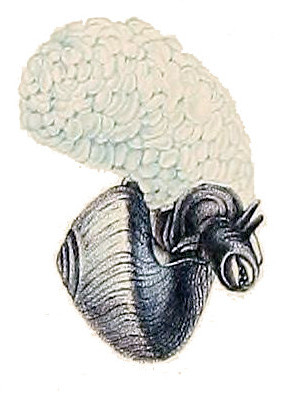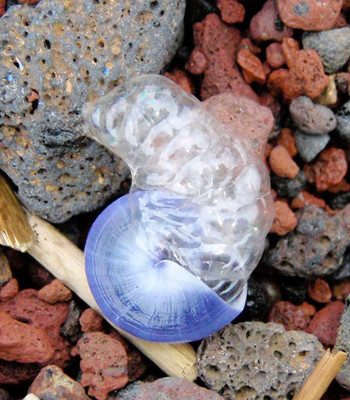
This post is also available in: Dutch (below)
This post was first published on November 22, 2013
In 1758 Linnaeus gave the scientific name Janthina janthina to a tiny and very delicate purple / blue snail shell and its snail inhabitant. The popular names for this species, which occurs in warm waters worldwide, range from ‘Purperen’ or ‘Paarse zeezeiler’ in Dutch to Common purple snail in English.
The animal is not rare, but the color of the shell it produces certainly is. There are very few naturally blue / purple shells in the world, making this species quite striking, as small as it is. Especially if you have the possibility to observe Macro shots of the shell in question. Than it quickly becomes clear how very finely patterned the shell is. The thin rounded shell of Janthina Janthina can be up to 3 centimetres wide and about 4 centimetres high and is so fragile that a happy finder must handle it very carefully. A too heavy-handed approach reduces it to grit in seconds.
Moreover it is not only the shell which has the particular color, the snail itself is violet colored and the animal has a long cylindrical snout with a mouth on its head.
Floating snail

This particular purple snail is a real “world citizen”. It doesn’t live on a permanent location in the sea, something many snails do, but travels from one spot to another. The name already indicates its behavior but it’s the way the animal moves over the sea surface which is very special. The animal floats on the surface of the sea and its floating ability is due to a kind of ‘raft’ of air bubbles which the animal binds together with a type of mucus containing chitin. This is produced in the tissue of the foot (located at the underside of the snail) by the animal itself. The snails do not swim but float by means of the raft of bubbles, which they can only produce at the surface of the sea.Under the influence of sea currents and wind, the animal travels on the sea surface while searching for food in the form of plankton and mainly juvenile jellyfish, such as the Portuguese Man of War, which also floats on the surface.
It’s because the Janthina Janthina is so sensitive to wind, that the chances of finding the shells on the beach are a lot better after a period of rough seas and strong winds.
Viviparous
The Purple sailor is viviparous in the sense that the females produce eggs that hatch in the genital tract. After hatching the larvae leave the tract. The reproductive process of the snails, however, can in no way be compared to the process of mammals. Male snails have no penis. The sperm cells swim to the female, and enter the genital tract after which the eggs are fertilized.
English name: Common purple snail
Papiamentu name: –
Scientific name: Janthina janthina
Family: Epitoniidae (Wentletraps)
Occurrence (ABC islands): Aruba, Bonaire and Curaçao

Paarse zeezeiler (Janthina janthina)
Zeldzaam blauw/paars

This post is also available in: Dutch (below)In 1758 gaf Linnaeus een minuscuul klein en zeer teer paars/blauw schelpje en de bijbehorende slak de wetenschappelijke naam Janthina janthina. De populaire benaming voor deze soort, die wereldwijd voorkomt in warme wateren, varieert van Purperen of Paarse zeezeiler in het Nederlands tot Common purple snail in het Engels.
Het dier is niet zeldzaam, maar de kleur van de schelp die het produceert is dat wel. Er zijn namelijk maar heel weinig blauw/paarse schelpen op de wereld, waardoor deze soort, zo klein als het is, behoorlijk opvalt. En helemaal als je de macro opnamen van de schelp in kwestie kunt observeren, waarbij het al snel duidelijk wordt hoe bijzonder fijn getekend de schelp is. De ronde dunne schelp van de Janthina janthina kan tot ongeveer 4 centimeter hoog en 3 centimeter breed worden en is zo fragiel dat een gelukkig vinder er zeer voorzichtig mee moet omgaan omdat het bij een te hardhandige aanpak in gruis veranderd.
Niet alleen de schelp heeft trouwens de bijzondere kleur, het slakje zelf is violet van kleur. Op de kop van het dier zit een lange cilindervormige snuit met een mondje.
Drijvende slak

Dit bijzondere paarse slakje is een echte ‘wereldburger’. Het leeft namelijk niet op een vaste plek in de zee, wat veel slakken wel doen, maar reizen van de ene spot naar de andere. De Paarse zeezeiler geeft het in zijn naam al aan. De manier waarop het dier zich verplaatst is echter heel bijzonder. Het dieren drijft namelijk aan de oppervlakte van de zee waar het blijft ronddrijven als gevolg van een soort ‘vlot’ van luchtbellen wat het dier aan elkaar bindt met een vorm van chitine bevattend slijm. Dit produceert het dier zelf uit het weefsel van de voet (de onderkant van de slak). De slakken zwemmen dus niet, maar drijven met behulp van het vlot van luchtbellen, die ze overigens alleen aan het oppervlakte van het zeewater kunnen maken.
Onder invloed van de zeestroming en de wind wordt het diertje aan het wateroppervlak meegevoerd, terwijl het zoekt naar voedsel in de vorm van plankton en voornamelijk juveniele kwalletjes, zoals het Portugees Oorlogsschip, dat ook aan de oppervlakte drijft.
Doordat de Janthina janthina zo windgevoelig is, is de kans op het vinden van de schelpjes op het strand na een periode van ruige zee en harde wind, een stuk groter.
Levend barend
De Paarse zeezeiler is levendbarend in de zin dat de eieren die de vrouwtjes produceren uitkomen in het geslachtskanaal, waarna de larven deze verlaten. Het reproductieve proces lijkt echter op geen enkele wijze op die van zoogdieren. Mannelijke slakken hebben namelijk geen penis. De spermacellen zwemmen naar het vrouwtje toe en betreden het geslachtskanaal waarna de eitjes van het wijfje worden bevrucht.
Nederlandse naam: Purperen zeezeiler
Papiamentse naam: –
Wetenschappelijke naam: Janthina janthina
Family: Epitoniidae (Wenteltrappen)
Voorkomen (ABC eilanden): Aruba, Bonaire en Curaçao